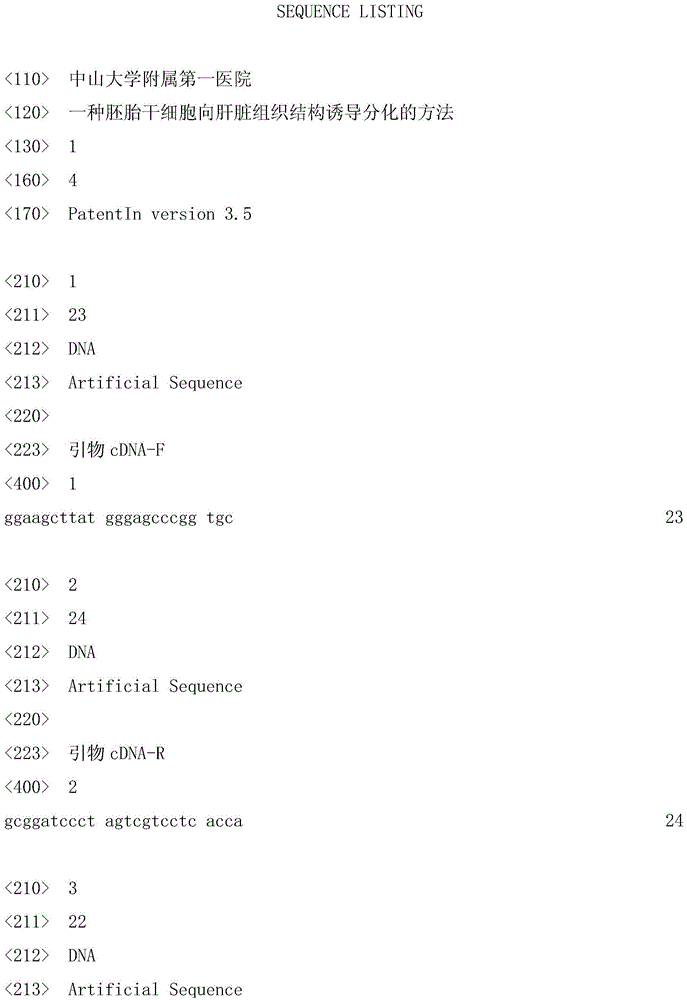Method for inducing differentiation of embryonic stem cells into liver tissue structure
A technology of embryonic stem cells and liver tissue, applied in the field of cell culture, to achieve the effect of perfect function
- Summary
- Abstract
- Description
- Claims
- Application Information
AI Technical Summary
Problems solved by technology
Method used
Image
Examples
Embodiment 1
[0055] Embodiment 1 Construction of Embryonic Stem Cells Highly Expressing E-cadherin Gene
[0056] (1) Design primers (cDNA-F: 5'-GGAAGCTTATGGGAGCCCGGTGC-3', cDNA-R: 5'-GCGGATCCCTAGTCGTCCTCACCA-3') according to the complete cDNA sequence information of the mouse E-cadherin gene (ACCESSION-AF167441);
[0057] (2) Using the total RNA of the liver tissue of BALB / c mice as a template, reverse transcription to obtain a cDNA template; use the template and the primers involved in step (1) to perform PCR amplification to obtain the E-cadherin gene;
[0058] (3) The PCR product that step (2) obtains is connected with eukaryotic cell pCAG-MCS carrier (purchased from Yrbio company) plasmid connection, constructs pCAG-E-cadherin plasmid, then transforms competent Escherichia coli and cultivates a large amount of extracted plasmids;
[0059] (4) The pCAG-E-cadherin recombinant plasmid was transfected into embryonic stem cells by liposome-mediated method and G418 screening was performed; a...
Embodiment 2 3
[0060] Embodiment 2 three-dimensional culture system establishment
[0061] (2) Establishment of a three-dimensional culture system: collagen scaffold particles (purchased from a reagent company, derived from cow skin collagen), the size of each scaffold particle is about 3×3×2mm, and the internal pore size of the particle is 400um. Each scaffold particle has been micromanipulated Cut to form a 1mm gap to obtain a three-dimensional culture system for semi-open collagen scaffold particles; before use, add culture medium (composed of basal medium and additives; the basal medium is preferably DMEM medium; the additives include: volume fraction of 20%) Fetal bovine serum, 2-mercaptoethanol with a final concentration of 0.1M, HEPES with a final concentration of 25mM, penicillin with a final concentration of 100U / mL, and streptomycin with a final concentration of 100μg / mL) to centrifuge the collagen scaffold particles It was precipitated and then cultured overnight at 37°C.
Embodiment 3
[0062] Example 3 Method for Inducing Differentiation of Embryonic Stem Cells to Liver Tissue Structure
[0063] (1) E-cadherin-ESC cells are induced into embryoid bodies: the E-cadherin-ESC cells prepared in Example 1 were cultured in suspension for 6 days to develop and differentiate into embryoid bodies comprising three germ layer structures; the medium for suspension culture It consists of basal medium and supplements; the basal medium is DMEM medium; the supplements include the following components: fetal calf serum with a volume fraction of 20%, 2-mercaptoethanol with a final concentration of 0.1M , HEPES with a final concentration of 25 mM, penicillin with a final concentration of 100 U / mL and streptomycin with a final concentration of 100 μg / mL;
[0064] (2) Induction of E-cadherin-ESC cells to the liver tissue structure: then transplant the embryoid bodies prepared in step (1) into the three-dimensional culture system of semi-open collagen scaffold particles prepared i...
PUM
 Login to View More
Login to View More Abstract
Description
Claims
Application Information
 Login to View More
Login to View More - R&D
- Intellectual Property
- Life Sciences
- Materials
- Tech Scout
- Unparalleled Data Quality
- Higher Quality Content
- 60% Fewer Hallucinations
Browse by: Latest US Patents, China's latest patents, Technical Efficacy Thesaurus, Application Domain, Technology Topic, Popular Technical Reports.
© 2025 PatSnap. All rights reserved.Legal|Privacy policy|Modern Slavery Act Transparency Statement|Sitemap|About US| Contact US: help@patsnap.com



